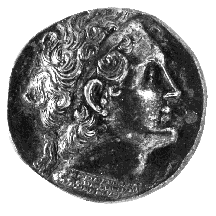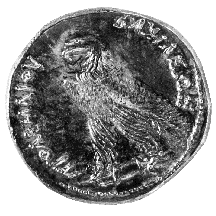



(59) Egypt, Ptolemy V Epiphanes - AR tetradrachm, 204-180 B.C.,
13.47 g. (inv. 91.101).
Obverse: Bust of Ptolemy I Soter r., wearing diadem and aegis.
Reverse: Eagle standing l. on thunderbolt; ![]()
![]() : of King
Ptolemy.
: of King
Ptolemy.
Provenance: Edward Gans, 1960.
Bibliography: O. Mørkholm, Early Hellenistic Coinage from the
Accession of Alexander to the Peace of Apamea (336-188 B.C.) (Cambridge
1991).
The Ptolemies greatly revered the founder of their dynasty, Ptolemy I Soter,
and retained his portrait head on their common silver tetradrachms until
the end of the dynasty (see nos. 54, 55). The eagle and thunderbolt on the
reverse, attributes of his patron deity, Zeus, were his personal device.
This coin was issued in the name of Ptolemy V Epiphanes (Illustrious), who
was born to the throne and whose coming of age and crowning in 197 B.C.
provided the occasion of the decree of the priests of Memphis recorded on
the Rosetta Stone. During its war with Syria from 202 to 200 B.C., Egypt
needed to issue coins in several localities. Many of the issues were the
conventional types, including the Soter tetradrachm.
The portrait shows considerable change in the characteristics of Ptolemy
I from the coins he issued for himself (compare no. 54). Although the typical
Soter features, the prominent, obstinate chin and the bulging forehead,
are recognizable, the portrait is more idealized and youthful, the eye larger,
the nose straighter and less beaked.
K.J.B.



All contents copyright (c) 1996.
Lawrence University
All rights reserved.